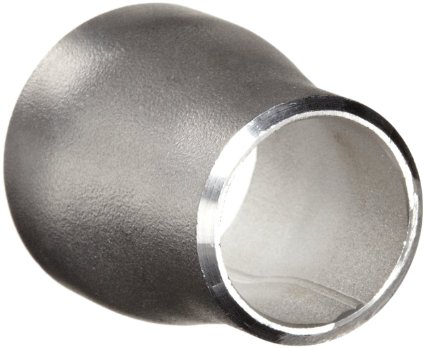
Stainless Steel Reducer
Butt Weld fitting:Reducer Concentric and Eccentric
Reducers be applied, to change from pipe diameter in one direction. Standard there are 2 possibilities, the concentric reducer, is usually used in vertical pipe lines, and the eccentric 1/2 reducer that is used in horizontal pipe lines.
On an isometric view, in a horizontal line, with a eccentric reducer must be declared, or the flat side at the bottom or top must be assembled. Perhaps, you have ever seen on a drawing, the abbreviation “TF” or “BF”. This stands for respective “top 1/2flat” and “bottom 1/2flat” For example:
- Bottom flat eccentric reducer are often be used in pipe racks to keep the pipeline at the same elevation, after a pipe size change. When a concentric or a flat on top eccentric reducer in a pipe rack will be used, the support detail, probably change.
- Top flat eccentric reducer are often be used in pump suction lines to avoid accumulation of gas pockets.Eccentric reducers can avoid small “dead spots” that exist behind concentric reducers.
Some draughtsmen also specify the size difference 1/2T 1/2between the center lines. As a eccentric reducer in a vertical line is used, it may also be important, which side should be oriented to the north, south, east or west. 1/2
Length of reducers
The length of a Reducer is very short in relation to the diameter, so in some dimensions the transition from one to another diameter is very abruptly. For example, a reducer NPS 6 – NPS 2 1/2 has a length of 140 1/2mm. On this short distance a pipeline will be reduced from 168.3 mm O.D. to 73 mm O.D. During the design phase of a new pipe system, a piping designer certainly must think about it. An alternative for a smoother flow would be to apply multiple reducers like:
- NPS 6 – NPS 5 (L=140 mm)
- NPS 5 – NPS 4 (L=127 mm)
- NPS 4 – NPS 3 1/2 (L=102 mm)
- NPS 3 1/2 – NPS 3 (L=102 mm)
- NPS 3 – NPS 2 1/2 (L=102 mm)
A reducer is the component in a pipeline that reduces the pipe size from a larger to a smaller bore (inner diameter). The length of the reduction is usually equal to the average of the larger and smaller pipe diameters.
There are two main types of reducer: concentric reducers and eccentric reducers. A reducer can be used either as nozzle or as diffuser depending on the mach number of the flow. A reducer allows for a change in pipe size to meet hydraulic flow requirements of the system, or to adapt to existing piping of a different size.
Reducers are usually concentric but eccentric reducers are used when required to maintain the same top-or bottom-of-pipe level. These fittings are manufactured in inch and metric size. Butt welding reducers are produced by pressing. The semi-finished product is rolled seamless tubes.
Dimensions and dimensional tolerances of welding reducers
Reducers are mainly used as part of pipelines in the construction, energy engineering and mining industry. Dimensions of tube reducers are: outside diameter of 26.9 -114, 3 mm, wall thickness from 2.3 to 3.6 mm, NPS 3/4 – 4 Steel for butt welding reducers Reducers are made from carbon and low alloy steels, dimensional tolerances are in accordance with relevant standards.
Heat treatment, condition of delivery and surface
The input tubes used for production of reducers are heat treated. Reductions are delivered with the inner and outer surface descaled not preserved, without surface protection or with surface treated by blasting.
Ends customization of the reducers
Upon agreement it is possible to supply reducers with a wall thickness of more than 3 mm with adjustment for a weld according to DIN 2559 standard
Testing of weld reducers
The input tubes and ready made reducers are tested according to requirements and the appropriate standards.
Marking of the weld reducers
Reducers are marked as required by standards or agreement. Marking is done usually by stamping the agreed data. Packaging of weld reducers Reducers are packaged in cardboard boxes or metal pallets.
Certificates for weld reducers Certificates are issued according to either DIN 50049 or EN 10204 standards.







